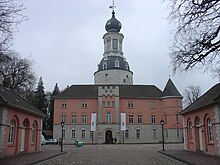Jever Castle
The Jever castle in Jever in Lower Saxony is based on a stronghold of the East Frisian chieftains and the seat was the rule Jever . It is the most important secular building in the city.
history
At the site of today's castle since the Middle Ages was already a fortress , which formed the core of the future town. The old fortress was completely destroyed in 1427 as a result of disputes between the chief families. From 1428 a new castle was built under Hayo Harlda and subsequently expanded by his descendants Tanno Duren and Edo Wiemken . The focal point was a mighty keep , which from the 16th century was integrated into a four-winged palace complex surrounded by moats and ramparts. From 1560 to 1564, the then regent Maria von Jever had various renovations carried out in the style of the Renaissance . Among other things, she had the carved coffered ceiling move into the audience hall.
In 1667, the rule of Jever and the castle came into the possession of the Principality of Anhalt-Zerbst . The Anhalt rulers, whose own principality in what is now Saxony-Anhalt was many days' journey from Jever, seldom stayed in the castle and therefore hardly made any major changes. It was only under Prince Johann August that the mighty central tower, which completely dominates the small courtyard, was crowned with its baroque dome from 1731 to 1736 . The 67 meter high tower is the landmark of the city today and can be found together with the castle as a trademark of the Jever Pilsener .
After the Zerbst division in 1793 until her death in 1796, Johann August's granddaughter, Tsarina Katharina, was the great owner of the castle. However, due to her obligations in Russia , she did not live in the castle during this period. In 1818 Jever fell to the Grand Duchy of Oldenburg . The castle was used by the Dukes of Oldenburg as a secondary residence and the old defenses were demolished in this context. Part of the former farm building was also demolished and the immediate area of the castle island was transformed into a landscape garden.
The Jever Castle Museum has been located in the castle since 1921, and is dedicated to both the history of the building and the Jever reign. In addition, changing exhibitions take place in the castle.
literature
- Karl Fissen: Castle and Palace of Jever. From the history of the Jeverse Castle from its beginnings to the present with numerous pictures and plans. 2nd edition, Oldenburg 1963
- Peter Pracher: The leather wallpapers from Jever Castle and from the monastery "Zur Ehre Gottes" in Wolfenbüttel , in: Hans-Herbert Möller (Ed.): Restoration of cultural monuments. Examples from the preservation of monuments in Lower Saxony (= reports on the preservation of monuments in Lower Saxony , supplement 2), Lower Saxony State Administration Office - Institute for Monument Preservation , Hameln: Niemeyer, 1989, pp. 339–346
- Antje Sander (Ed.): The Miss and the Renaissance. Maria von Jever 1500-1575. Dominance and culture in a 16th century Frisian residence . Isensee, Oldenburg 2000, ISBN 3-89598-711-5 .
- Antje Sander: The castle in Jever - construction activity and use among the Oldenburgers . In: Jörgen Welp (Red.): Dedicated to the well-being of Oldenburg: Aspects of the cultural and social work of the House of Oldenburg, 1773–1918 (= publications of the Oldenburg landscape . Vol. 9). Published by the Oldenburg landscape, Isensee, Oldenburg 2004, ISBN 3-89995-142-5 , p. 55 ff.
- Ernst Andreas Friedrich : The underground passage from Jever , pp. 182-185, in: If stones could talk , Volume I, Landbuch-Verlag, Hannover 1989, ISBN 3-7842-03973 .
Web links
- Entry by Frank Both about Schloss Jever in the scientific database " EBIDAT " of the European Castle Institute
- Jever Castle Museum
- Development of the castle on the north-west cultural portal
- Reconstruction drawing
- Jever Castle in the Lower Saxony Monument Atlas
Coordinates: 53 ° 34 ′ 20 ″ N , 7 ° 54 ′ 11 ″ E


